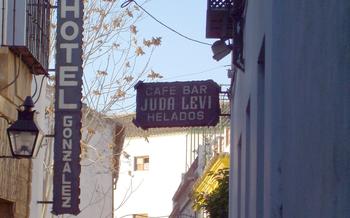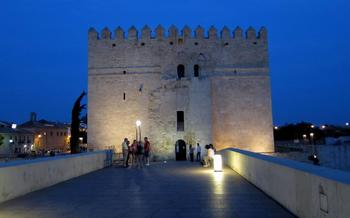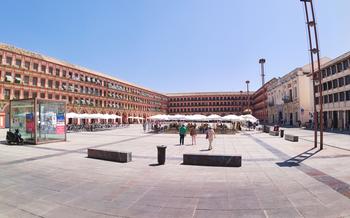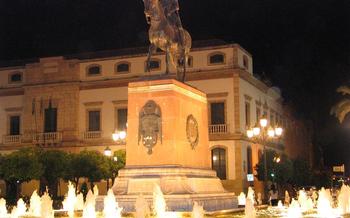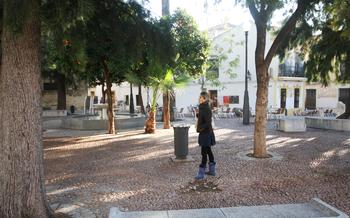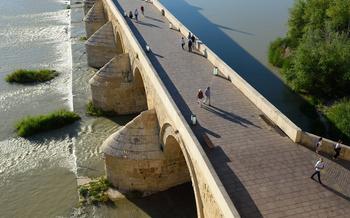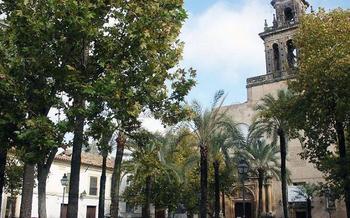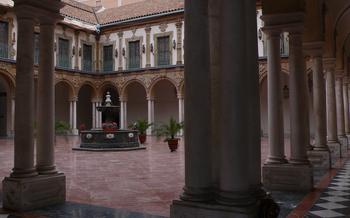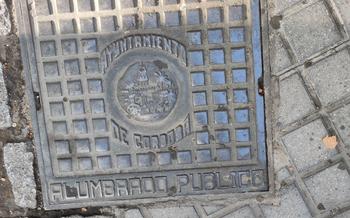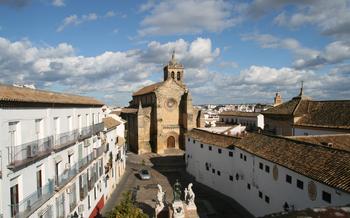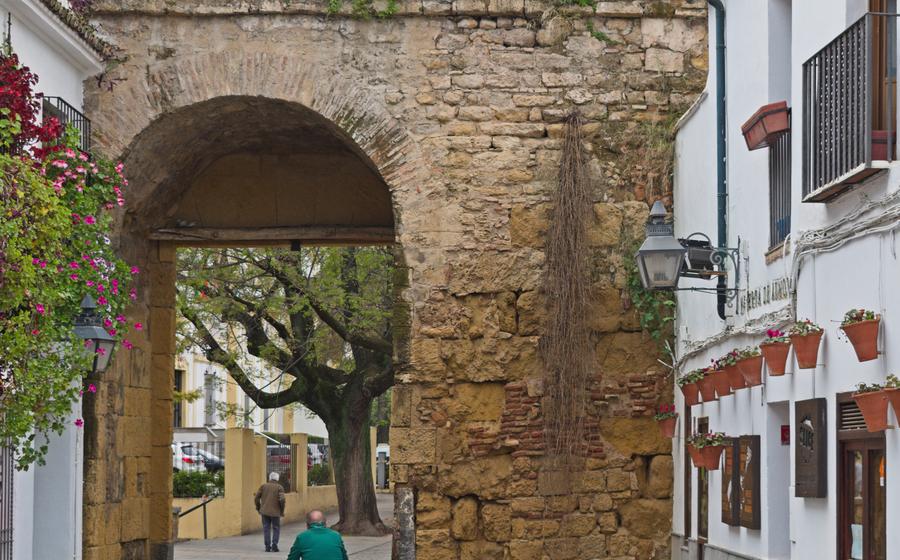
Puerta de Almodóvar
- The Puerta de Almodóvar: A Gateway to History
- Exploring the Origins: The Almohads
- Puerta de Almodóvar's Defensive Role
- Gateway to the Medina:
- The Tower of La Calahorra: A Guardian of the Gate
- Puerta de Almodóvar's Architectural Details
- A Thriving Marketplace
- The Jewish Quarter: A Historic Neighborhood
- Casa de Sefarad: A Cultural Center
- The Synagogue: A Sacred Space
- The Hammam: A Place of Relaxation
- The Souk: A Vibrant Market
- Local Cuisine: A Culinary Adventure
- Flamenco: A Cultural Expression
- Insider Tip:
The Puerta de Almodóvar: A Gateway to History
In the heart of Córdoba, Spain, stands the majestic Puerta de Almodóvar, a gateway that has witnessed centuries of history and played a pivotal role in shaping the city's identity. This imposing gate, dating back to the 13th century, is a testament to the city's rich cultural heritage, blending Islamic and Gothic influences in its architectural design.
Historical Significance:
The Puerta de Almodóvar was constructed during the reign of the Almohads, a Berber dynasty that ruled over much of the Iberian Peninsula from the 12th to the 13th century. It served as a strategic entrance to the city, connecting the outer suburbs with the bustling medina, the city's historic quarter. The gate's strategic location and defensive features made it a crucial part of Córdoba's fortifications, protecting the city from potential invaders.
Architectural Features:
The Puerta de Almodóvar is a remarkable example of Almohad architecture, characterized by its horseshoe arch, intricate carvings, and blend of Islamic and Gothic elements. The gate's horseshoe arch is a distinctive feature, reflecting the Moorish influence that shaped much of Córdoba's architecture. The arch is adorned with intricate carvings and decorative elements, showcasing the craftsmanship and artistry of the period.
Location and Accessibility:
The Puerta de Almodóvar is conveniently located in the heart of Córdoba, within walking distance from many of the city's main attractions. It is situated on the western edge of the historic center, near the Guadalquivir River, making it easily accessible for visitors exploring the city on foot or by bike.
Exploring the Origins: The Almohads
The Puerta de Almodóvar, a testament to the architectural prowess of the Almohads, stands as a reminder of their profound influence on Córdoba's rich history. This Berber dynasty, hailing from North Africa, swept into Spain during the 12th century, leaving an indelible mark on the Iberian Peninsula. Their reign ushered in a period of cultural and intellectual flourishing, with Córdoba emerging as a prominent center of learning and artistry.
The Almohads, known for their mastery of engineering and construction, embarked on an ambitious project to fortify Córdoba's defenses. The Puerta de Almodóvar, a formidable gateway, epitomizes their strategic vision. Its towering presence guarded the city's western approach, deterring potential invaders and safeguarding the thriving metropolis within.
The gate's construction coincided with a period of intense conflict and political upheaval. The Almohads, driven by their religious fervor, sought to expand their dominion and establish a vast Islamic empire stretching from North Africa to the Iberian Peninsula. Córdoba, a pivotal city in this struggle, required robust fortifications to withstand the relentless attacks from Christian forces.
Puerta de Almodóvar's Defensive Role
The Puerta de Almodóvar played a crucial role in protecting the city of Córdoba during its long history. Its strategic location at the edge of the Medina, the old city, made it a vital point of defense. The gate's massive construction, featuring thick walls and a sturdy tower, acted as a formidable barrier against potential invaders.
The gate's defensive features included a series of arrow slits and machicolations, allowing defenders to launch projectiles and pour boiling oil or water onto attackers below. The gate's narrow passageway could be easily blocked or barricaded, making it difficult for enemies to force their way through.
Throughout Córdoba's history, the Puerta de Almodóvar stood as a symbol of the city's resilience and strength. It played a key role in repelling attacks from various forces, including the Christian armies during the Reconquista, and served as a testament to the city's ability to withstand adversity.
Gateway to the Medina:
The Puerta de Almodóvar served as a gateway to the old city, known as the Medina. The Medina was a bustling center of commerce, with narrow streets lined with shops and stalls selling various goods. The gate's strategic location allowed for easy access to the Medina, facilitating the movement of people and goods.
At the gate's entrance, visitors would have encountered the lively atmosphere of the Medina. The gate served as a meeting point for locals and travelers, creating a vibrant and diverse community. The Medina's layout was characterized by its labyrinthine network of streets, adding to its charm and mystique.
The significance of the gate's location extended beyond its commercial importance. It held symbolic value as the main entrance to the city, welcoming visitors and residents alike. The gate stood as a symbol of Córdoba's rich history and cultural heritage, inviting people to explore the city's hidden treasures.
The Tower of La Calahorra: A Guardian of the Gate
Perched majestically alongside the Puerta de Almodóvar, the Tower of La Calahorra stands as an imposing sentinel, guarding the entrance to the historic city of Córdoba. Constructed in the 14th century, this formidable tower served as a crucial defensive structure, providing an elevated vantage point for spotting approaching enemies and signaling warnings to the city.
The tower's distinctive horseshoe-shaped design, reminiscent of Islamic architecture, blends seamlessly with the Gothic elements that adorn its facade. Its sturdy walls, punctuated by narrow windows and crenellated battlements, exude an air of impregnability. La Calahorra's strategic location allowed guards to monitor both land and river traffic, ensuring the city's safety from potential threats.
During times of siege, the tower played a pivotal role in protecting Córdoba. Its fortified structure provided a secure refuge for soldiers and civilians alike, who sought shelter within its walls to escape the ravages of war. The tower's strategic position also enabled defenders to launch counterattacks and repel enemy forces, contributing to the city's successful defense.
Today, the Tower of La Calahorra stands as a testament to Córdoba's rich history and resilience. Visitors can climb to the tower's summit to enjoy breathtaking panoramic views of the city and the surrounding countryside. Its walls whisper tales of battles fought and won, and its presence serves as a reminder of the city's enduring strength and spirit.
Puerta de Almodóvar's Architectural Details
The Puerta de Almodóvar stands as a testament to the architectural prowess of the Almohads, showcasing a harmonious blend of Islamic and Gothic influences. The horseshoe arch, a signature element of Islamic architecture, dominates the gate's façade, evoking a sense of grandeur and craftsmanship. Decorative elements, such as intricate carvings and geometric patterns, adorn the archway, adding a touch of elegance and artistry to the structure. These decorative accents showcase the attention to detail and the aesthetic sensibilities of the Almohads, who sought to create not just a functional gateway but also a visually captivating work of art.
The gate's blend of Islamic and Gothic influences reflects the cultural crossroads that Córdoba represented during the Middle Ages. The horseshoe arch, a symbol of Islamic heritage, stands in contrast to the pointed arch, a feature commonly associated with Gothic architecture. This unique combination of architectural elements creates a visually striking and historically significant structure that encapsulates the city's rich past.
A Thriving Marketplace
The Puerta de Almodóvar was not just a gateway to the city but also a bustling marketplace. Its strategic location at the entrance to the Medina made it an ideal spot for traders and merchants to set up their stalls. The gate area buzzed with activity as vendors displayed their wares, enticing passersby with colorful textiles, exotic spices, and handcrafted goods.
The market was a vibrant hub of commerce, where locals and travelers alike converged to buy and sell. Merchants from far-off lands brought their unique products to Córdoba, adding to the gate's cosmopolitan atmosphere. The air was filled with the sounds of haggling, bargaining, and the cheerful banter of traders. The sights and sounds of the marketplace were a testament to the city's thriving economy and cultural diversity.
Beyond the commercial aspect, the market also served as a social gathering place. People came together to exchange news, gossip, and stories. The market was a place to meet friends, make connections, and experience the lively energy of the city.
Today, the market at Puerta de Almodóvar has been replaced by souvenir shops and tourist stalls. However, the gateway still retains its lively atmosphere, evoking the spirit of the bustling marketplace that once thrived within its walls.
The Jewish Quarter: A Historic Neighborhood
Situated just a stone's throw from the Puerta de Almodóvar, the Jewish Quarter stands as an enduring testament to Córdoba's rich and multifaceted history. This historic neighborhood, known as La Judería, evokes a palpable sense of the past, transporting visitors back to a time when the city served as a thriving center of Jewish culture and scholarship.
During the Middle Ages, Córdoba was home to a substantial Jewish community, and La Judería served as the heart of their communal life. It was here that the city's Jews established their homes, synagogues, schools, and businesses, creating a vibrant and self-contained community within the larger urban fabric.
The Jewish Quarter's narrow and winding streets, lined with whitewashed houses adorned with intricate ironwork balconies, offer a glimpse into the daily life of Córdoba's Jewish inhabitants. The district is home to several significant landmarks, including the Synagogue, the Casa de Sefarad, and the Hammam, which collectively provide visitors with a deeper understanding of the community's history, culture, and traditions.
La Judería's rich legacy is celebrated each year during the Festival de las Tres Culturas, which brings together people from all over the world to commemorate the city's diverse heritage through music, dance, food, and exhibitions. This lively festival is a testament to Córdoba's enduring spirit of tolerance and coexistence, and it serves as a reminder of the important role that the Jewish community played in shaping the city's cultural tapestry.
Casa de Sefarad: A Cultural Center
Located just a stone's throw from the Puerta de Almodóvar, the Casa de Sefarad is a vibrant cultural center dedicated to preserving and promoting the rich history and heritage of the Jewish community in Córdoba. Housed in a beautifully restored 14th-century building, the center offers a range of exhibitions, events, and educational programs aimed at fostering understanding and appreciation of Jewish culture.
Visitors to the Casa de Sefarad can explore interactive displays that delve into the history of the Jewish community in Córdoba, from its origins in Roman times to its flourishing during the Middle Ages and its eventual expulsion in 149The center also hosts temporary exhibitions showcasing Jewish art, artifacts, and traditions from around the world.
One of the highlights of the Casa de Sefarad is its Sephardic Cultural Center, which offers a variety of workshops, lectures, and performances celebrating Jewish culture. Visitors can learn about traditional Jewish music, dance, and cuisine, as well as participate in discussions on Jewish history, philosophy, and religion.
The Casa de Sefarad is a must-visit for anyone interested in exploring the rich cultural heritage of Córdoba. Through its engaging exhibitions and programs, the center provides a unique opportunity to learn about the significant contributions of the Jewish community to the city's past and present.
The Synagogue: A Sacred Space
Situated in the heart of the Jewish Quarter, a short stroll from the Puerta de Almodóvar, stands the historic Synagogue, a testament to the vibrant Jewish community that once called Córdoba home. Built in the 14th century, this well-preserved synagogue is one of the few remaining in Spain and offers a glimpse into the rich cultural and religious heritage of the city's Jewish population.
As you step through the unassuming entrance, you are greeted by an atmosphere of tranquility and reverence. The synagogue's interior is a testament to the craftsmanship and artistry of its builders. Intricate stucco work adorns the walls, featuring geometric patterns and verses from the Torah. The central feature of the synagogue is the bimah, a raised platform used for reading the Torah scrolls. The bimah is surrounded by elaborately carved wooden panels, each telling a unique story from Jewish history.
The synagogue's most striking feature is its Mudéjar-style ceiling, a combination of Islamic and Gothic influences. The ceiling is made up of intricately carved wooden beams, forming a network of stars and polygons that create a sense of awe and wonder. The play of light and shadow through the ceiling's openings creates a magical effect, transforming the synagogue into a sacred space that invites contemplation and reflection.
The Córdoba Synagogue stands as a symbol of the city's rich and diverse past. It is a reminder of the contributions made by the Jewish community to the cultural tapestry of Córdoba and a testament to the enduring legacy of religious tolerance and coexistence in the city.
The Hammam: A Place of Relaxation
Located just a short walk from the Puerta de Almodóvar, the Hammam is a must-visit for those seeking a truly immersive cultural experience. This historic bathhouse dates back to the 10th century and has been beautifully preserved, offering visitors a glimpse into the bathing rituals and traditions of the past.
Step inside and be transported to a world of tranquility and relaxation. The air is filled with the soothing sound of running water and the scent of aromatic oils. The hammam features several chambers, each with its own unique temperature and humidity. Start in the warm chamber, where you can let your muscles relax and unwind. Then, move to the hot chamber, where you can experience the invigorating effects of steam and heat. Finally, cool off in the cold chamber, which will leave you feeling refreshed and revitalized.
In addition to the traditional bathing experience, the Hammam also offers a variety of massages and treatments. Treat yourself to a relaxing massage with aromatic oils, or indulge in a traditional Moroccan scrub, which will leave your skin feeling soft and smooth.
Whether you're looking to relax and unwind or to experience a unique cultural tradition, the Hammam is the perfect place to do so. So, take a break from your sightseeing and step into this oasis of tranquility for a truly unforgettable experience.
The Souk: A Vibrant Market
The Puerta de Almodóvar is not just a historical monument but also a gateway to a vibrant marketplace. The souk, located just outside the gate, is a bustling hub of activity where locals and tourists alike come together to buy and sell goods. The air is filled with the sounds of haggling, the smell of spices, and the colors of traditional Moroccan crafts.
Strolling through the souk is a feast for the senses. Vendors display their wares on colorful stalls, from intricately woven carpets and handmade pottery to aromatic spices and delicious pastries. The atmosphere is lively and friendly, and visitors are encouraged to bargain for the best prices. The souk is also a great place to find unique souvenirs and gifts to take home.
If you're looking for a truly authentic Moroccan experience, be sure to visit the souk near the Puerta de Almodóvar. It's a great place to immerse yourself in the local culture, shop for souvenirs, and sample some of the delicious local cuisine.
Local Cuisine: A Culinary Adventure
Córdoba's culinary scene is a symphony of flavors, offering a tantalizing blend of traditional Spanish dishes and influences from various cultures that have graced the city throughout history. In the vicinity of Puerta de Almodóvar, you'll find an array of restaurants and eateries catering to every palate.
Indulge in the iconic salmorejo cordobés, a chilled tomato soup with a velvety texture and garnished with diced ham and hard-boiled eggs. Savor the flamenquín, a deep-fried pork loin wrapped in Serrano ham and coated in breadcrumbs, a crispy and succulent delight. For a taste of the sea, try the pescaíto frito, a platter of freshly caught and fried fish, a staple of Andalusian cuisine.
Don't miss out on the rabo de toro, a slow-cooked oxtail stew that melts in your mouth, a testament to the region's rich culinary traditions. And for a sweet treat, succumb to the temptation of the pastel cordobés, a flaky pastry filled with cabello de ángel, a sweet squash jam, a local specialty that will leave you craving for more.
As you savor the delectable dishes, be sure to pair them with a glass of fino, a dry and refreshing sherry produced in the nearby Montilla-Moriles region, a perfect accompaniment to the local gastronomy.
Whether you're seeking a casual dining experience or a memorable gourmet feast, the culinary delights surrounding Puerta de Almodóvar will tantalize your taste buds and leave you with an unforgettable gastronomic journey.
Flamenco: A Cultural Expression
Flamenco, a captivating fusion of music, dance, and song, is the embodiment of Andalusian culture. This vibrant art form originated in the 18th century, weaving together diverse influences from the region's rich history. The soulful melodies, intricate footwork, and passionate expressions of flamenco captivate audiences worldwide.
In Córdoba, the beating heart of flamenco, the Puerta de Almodóvar area offers a vibrant stage for this cultural expression. Several renowned tablaos, or flamenco venues, are nestled within the historic streets, inviting visitors to immerse themselves in the passion and energy of this traditional art form.
Attending a flamenco performance near the Puerta de Almodóvar is a must for any traveler seeking an authentic cultural experience. The intimate venues provide an up-close and personal encounter with the raw emotion and artistry of flamenco. The mesmerizing performances showcase the incredible talent of the dancers, singers, and guitarists, leaving an indelible mark on the soul.
Whether you're a seasoned flamenco aficionado or a first-time enthusiast, the Puerta de Almodóvar area offers an unforgettable journey into the heart of this captivating art form. Prepare to be captivated by the mesmerizing rhythms, graceful movements, and heartfelt expressions that define the essence of flamenco.
Insider Tip:
-
Best time to visit: The best time to visit the Puerta de Almodóvar is during the shoulder seasons (spring and autumn) when the weather is pleasant and there are fewer tourists. If you're looking to avoid the crowds, try visiting early in the morning or late in the afternoon.
-
Guided tours: For a more in-depth experience, consider joining a guided tour. Guided tours are available in various languages and provide insights into the gate's history and architecture. Check with the local tourism office for tour schedules and prices.
-
Photography opportunities: The Puerta de Almodóvar is a photographer's dream. With its unique architecture and picturesque surroundings, there are plenty of opportunities to capture stunning photos. Remember to bring your camera and make sure it's charged!
